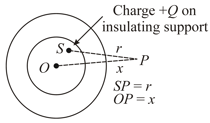MEDIUM
NEET
IMPORTANT
Earn 100
For the hollow thin cylinderical current carrying pipe which statement is correct :-
(a)magnetic field inside the pipe is not zero
(b)magnetic field outside the pipe is zero
(c)electric field outside the pipe is zero
(d)electric field on the surface of pipe is zero
28% studentsanswered this correctly

Important Questions on Electrostatics
HARD
NEET
IMPORTANT
If mechanical system is taken equivalent to electrical system then displacement is analogous to
MEDIUM
NEET
IMPORTANT
A charge of mass (fig.) is free to move when released at a distance '' from the fixed charge . Calculate its speed, when it recedes to a distance :

[Assume ]
MEDIUM
NEET
IMPORTANT
A point charge of mass is located at the centre of a ring having radius and charge with its axis oriented along - axis. When the point charge is displaced slightly, it accelerates along the -axis to infinity; the ultimate speed of the point charge (consider no energy loss in radiation) is
MEDIUM
NEET
IMPORTANT
An electron of mass initially at rest moves through a certain distance in a uniform electric field in time . A proton of mass also initially at rest takes time to move through an equal distance in this uniform electric field. Neglecting the effect of gravity, the ratio of is nearly equal to:
EASY
NEET
IMPORTANT
There is a uniform electric field of strength along -axis. A body of mass and charge is projected into the field from origin along the positive -axis with a velocity . Its speed in after is (neglect gravitation)
EASY
NEET
IMPORTANT
An elementary particle of mass and charge is projected with velocity towards a much more massive particle of charge , where . What is the closest possible distance of approach of the incident particle?
MEDIUM
NEET
IMPORTANT
An electric dipole is placed in a non uniform electric field, then it experiences:
MEDIUM
NEET
IMPORTANT
The adjacent diagram shows a charge held on an insulating support and enclosed by a hollow spherical conductor. represents the centre of the spherical conductor and is a point such that and . The electric field at point will be:

